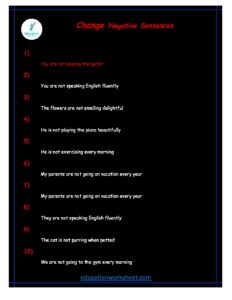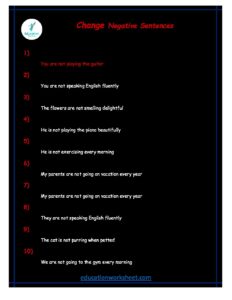Change Simple Present tense to Present Continuous negative tense 20 worksheets
Change Simple Present tense to Present Continuous negative tense
Understanding Simple Present Tense
Before we dive into the transformation process, let’s briefly revisit the Change Simple Present tense to Present Continuous negative tense. This tense is used to express habitual actions, general truths, and regular occurrences. In its affirmative form, it typically consists of the base form of the verb with the addition of ‘s’ or ‘es’ for third-person singular subjects, such as “He works,” “She studies,” or “They eat.”
Description of Change simple present tense to present continuous negative tense
Change Simple Present tense to Present Continuous negative tense, on the other hand, is employed when we want to convey actions that are ongoing in the present but in a negative context. To form this tense, we need the auxiliary verb “am,” “is,” or “are” (depending on the subject) along with “not,” and the base form of the verb + “ing.” This structure is used to indicate actions that are happening right now and are explicitly not taking place.
Change Simple Present tense to Present Continuous negative tense
Change simple present to present continuous negative tense

Now, let’s delve into the transformation of Change Simple Present tense to Present Continuous negative tense. This process involves three essential components: the subject, the auxiliary verb, and the main verb. We will break down each component and provide examples to illustrate the transformation.
Introduction and Detail of Change simple present to present continuous negative tenses
1. Subject
The subject of the sentence remains the same in both tenses. It could be a pronoun (e.g., I, you, he, she, it, we, they) or a noun (e.g., John, the cat, my friends).
2. Auxiliary Verb
In Simple Present Tense, we do not use auxiliary verbs for most subjects. However, in Present Continuous Negative Tense, we need to introduce the appropriate form of the auxiliary verb “am,” “is,” or “are” based on the subject. To determine which auxiliary verb to use, follow these guidelines:
- For the first person singular (I), use “am.”
- For the third person singular (he, she, it), use “is.”
- For all other subjects (you, we, they), use “are.”
3. Main Verb
In Simple Present Tense, the main verb is typically in its base form (e.g., work, study, eat). In Present Continuous Negative Tense, we add “not” after the auxiliary verb and change the main verb to the base form + “ing.”
Now, let’s put it all together with some examples:
Simple Present Tense:
- I work in the city.
- She studies French.
- They eat pizza.
Present Continuous Negative Tense:
- I am not working in the city.
- She is not studying French.
- They are not eating pizza.
In these examples, we can see how the auxiliary verb “am,” “is,” or “are” is introduced, and the main verb is transformed into the base form + “ing.” Additionally, “not” is included to make the sentences negative.
Practical Examples and Usage
To further solidify your understanding of this transformation, let’s explore some practical examples in different contexts
Present tenses Change Simple Present tense to Present Continuous negative tense

- Habitual Actions:
- Simple Present: He smokes.
- Present Continuous Negative: He is not smoking.
- General Truths:
- Simple Present: The Earth orbits the Sun.
- Present Continuous Negative: The Earth is not orbiting the Sun.
- Regular Occurrences:
- Simple Present: They visit their grandparents every Sunday.
- Present Continuous Negative: They are not visiting their grandparents today.
- Negative Actions:
- Simple Present: She doesn’t eat meat.
- Present Continuous Negative: She is not eating meat now.
- Routine Activities:
- Simple Present: We exercise in the morning.
- Present Continuous Negative: We are not exercising this morning.

As demonstrated in these examples, the transformation of Simple Present Tense into Present Continuous Negative Tense allows us to communicate a wide range of ideas, from describing ongoing negative actions to expressing deviations from routine.
Practice Makes Perfect
Mastering the transformation of Change Simple Present tense to Present Continuous negative tense requires practice and familiarity with the rules outlined above. To reinforce your understanding, consider these exercises:
- Transform the following Simple Present Tense sentences into Present Continuous Negative Tense:
- She eats breakfast every day.
- They watch TV in the evening.
- I speak Spanish fluently.
- Create your own Simple Present Tense sentences and transform them into Present Continuous Negative Tense.
- Engage in conversations with friends or language partners, incorporating both tenses into your dialogue

